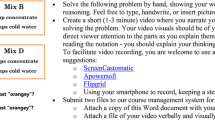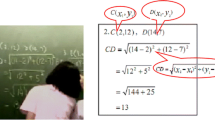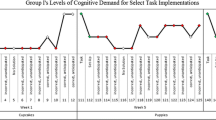Abstract
Interpreting and responding to student thinking are central tasks of reform-minded mathematics teaching. This study examined preservice teachers’ (PSTs) interpretations of and responses to a student’s error(s) involving finding a missing length in similar rectangles through a teaching scenario task. Fifty-seven PSTs’ responses were analyzed quantitatively and qualitatively. Analysis results revealed that although the student’s errors came from conceptual aspects of similarity, a majority of PSTs identified the errors as stemming from procedural aspects of similarity, subsequently guiding them by invoking procedural knowledge. This study also revealed two different forms of address and teaching actions in PST interventions along with three categories of acts of communication barriers. The broader implications of the study for international communities are discussed in accordance with the findings.

Similar content being viewed by others
References
Ashlock, R. B. (2006). Error patterns in computation: A semi-programmed approach (9th ed.). Columbus, OH: Charles E. Merrill.
Ball, D. L. (1990). Prospective elementary and secondary teachers’ understanding of division. Journal for Research in Mathematics Education, 21, 132–144.
Ball, D. L., & Bass, H. (2000). Interweaving content and pedagogy in teaching and learning to teach: Knowing and using mathematics. In J. Boaler (Ed.), Multiple perspectives on the teaching and learning of mathematics (pp. 83–104). Westport, CT: Ablex.
Baxter, G. & Junker, B. W. (2001). Designing developmental assessments: A case study in proportional reasoning. Paper presented at the Annual Meeting of the National Council of Measurement in Education, April 2001, Seattle, WA.
Begle, E. G. (1979). Critical variables in mathematics education: Findings from a survey of the empirical literature. Washington, DC: Mathematical Association of America and National Council of Teachers of Mathematics.
Ben-Chaim, D., Keret, Y., & Ilany, B. (2012). Ratio and proportion: Research and teaching in mathematics teachers’ education (pre-and in-service mathematics teachers of elementary and middle school classes). Rotterdam, the Netherlands: Sense.
Berk, D., Taber, S., Gorowara, C., & Poetzl, C. (2009). Developing prospective elementary teachers’ flexibility in the domain of proportional reasoning. Mathematical Thinking and Learning, 11(3), 113–135.
Blythe, T., Allen, D., & Powell, B. S. (1999). Looking together at student work: A companion guide to assessing student learning. New York: Teachers College Press.
Borasi, R. (1994). Capitalizing on errors as ‘springboards for inquiry’: A teaching experiment. Journal for Research in Mathematics Education, 25(2), 166–208.
Brendenfur, J. L. (2008). Connecting elementary teachers’ mathematical knowledge to their instructional practices. The Researcher, 21(2), 1–18.
Briars, D. J., & Siegler, R. S. (1984). A feature analysis of preschooler’s counting knowledge. Developmental Psychology, 20, 607–618.
Bright, G. W., Chambers, D. L., & Vacc, N. N. (Eds.). (1999). Incorporating cognitively guided instruction into elementary preservice teacher education programs: Results from a National Science Foundation research project. Madison, WI: University of Wisconsin, Wisconsin Center for Education Research.
Brown, C., & Borko, H. (1992). Becoming a mathematics teacher. In D. A. Grouws (Ed.), Handbook of research on mathematics teaching and learning. New York: Macmillan.
Carpenter, T. P., Fennema, E., Peterson, P. L., & Carey, D. A. (1988). Teachers’ pedagogical content knowledge of students’ problem solving in elementary arithmetic. Journal for Research in Mathematics Education, 19, 385–401.
Chamberlain, S. P. (2005). Recognizing and responding to cultural differences in the education of culturally and linguistically diverse learners. Intervention in School and Clinic, 40(4), 195–211.
Confrey, J., & Smith, E. (1995). Splitting, covariation and their role in the development of exponential functions. Journal for Research in Mathematics Education, 26(1), 66–86.
Currier, S., Cramer, K., & Post, T. (1993). Learning and teaching ratio and proportion: Research implications (pp. 159–178). New York: Macmillan.
Dossey, J., Halvorsen, K., & McCrone, S. (2008). Mathematics education in the United States 2008, a capsule summary fact book. Reston, VA: National Council of Teachers of Mathematics.
Eisenhart, M., Borko, H., Underhill, R. G., Brown, C. A., Jones, D., & Agard, P. C. (1993). Conceptual knowledge falls through the cracks: Complexities of learning to teach mathematics for understanding. Journal for Research in Mathematics Education, 24, 8–40.
Fernandez, C. Linares, S., & Valls, J. (2011). Development of prospective mathematics teachers’ professional noticing in a specific domain: Proportional reasoning. In the Proceedings of the 35th Conference of the International Group for the Psychology of Mathematics Education (Vol. 2, pp. 329–336). PME.
Fuson, K. C. (1988). Children’s counting and concepts of number. New York: Springer.
Boero, P., & Garuti, R. (1992). A sequence of proportionality problems: An exploratory study in the proceedings of the International Group for the Psychology of Mathematics Education, XVI (Vol. 1, pp. 225–232). Durham, NH: University of New Hampshire.
Hart, K. (1981). Ratio and proportion. In K. M. Hart (Ed.), Children’s understanding of mathematics: [ages] 11–16 (pp. 88–101). London: John Murray.
Hart, K. (1984). Ratio: Children’s strategies and errors. Windsor, England: NFER-Nelson.
Heinz, K., & Sterba-Boatwright, B. (2008). The when and why of using proportions. Mathematics Teachers, 101, 528–533.
Hewitt, K. (2001). Blocks as a tool for learning: A historical and contemporary perspective. Young Children, 56(1), 6–12.
Hiebert, J., & Lefevre, P. (1986). Conceptual and procedural knowledge in mathematics: An introductory analysis. In J. Hiebert (Ed.), Conceptual and procedural knowledge: The case of mathematics (pp. 1–27). Hillsdale, NJ: Lawrence Erlbaum Associates.
Hill, H. C., Rowan, B., & Ball, D. L. (2005). Effects of teachers’ mathematical knowledge for teaching on student achievement. American Educational Research Journal, 42(2), 371–406.
Hines, E., & McMahon, M. T. (2005). Interpreting middle school students’ proportional reasoning strategies: Observations from preservice teachers. School Science and Mathematics, 105(2), 88–105.
Kaput, J., & West, M. (1994). Missing-value proportional reasoning problems: Factors affecting informal reasoning patterns. In G. Harel & J. Confrey (Eds.), The development of multiplicative reasoning in the learning of mathematics (pp. 235–287). Albany, NY: State University of New York Press.
Karplus, R., Pulos, S., & Stage, E. (1983). Early adolescents’ proportional reasoning on ‘rate’ problems. Educational Studies in Mathematics, 14(3), 219–233.
Kilpatrick, J., Swafford, J., & Findell, B. (2001). Adding it up: Helping children learn mathematics. Washington, DC: National Academy Press.
Lamon, S. (1999). Teaching fractions and ratios for understanding: Essential content knowledge and instructional strategies for teachers. Hillsdale, NJ: Erlbaum.
Lamon, S. J. (2007). Rational numbers and proportional reasoning. In F. K. Lester Jr. (Ed.), Second handbook of research on mathematics teaching and learning (pp. 629–667). Charlotte, NC: Information Age.
Lannin, J. K., Barker, D. D., & Townsend, B. E. (2007). How students view the general nature of their errors. Educational Studies in Mathematics, 66, 43–59.
Lim, K. H. (2009). Burning the candle at just one end: Using nonproportional examples helps students determine when proportional strategies apply. Mathematics Teaching in the Middle School, 14, 492–500.
Ma, L. (1999). Knowing and teaching elementary mathematics: Teachers’ understanding of fundamental mathematics in China and the United States. Mahwah, NJ: Lawrence Erlbaum.
Mewborn, D. S. (2000). Learning to teach elementary mathematics: Ecological elements of a field experience. Journal of Mathematics Teacher Education, 3(1), 27–46.
Moss, J., & Case, R. (1999). Developing children’s understanding of the rational numbers: A new model and an experimental curriculum. Journal for Research in Mathematics Education, 30(2), 122–147.
NCTM. (1989). Curriculum and evaluation standards for school mathematics. Reston, VA: National Council of Teachers of Mathematics.
NCTM. (2000). Principles and standards for school mathematics. Reston, VA: National Council of Teachers of Mathematics.
NCTM. (2006). Curriculum focal points for prekindergarten through grade 8 mathematics: A quest for coherence. Reston, VA: National Council of Teachers of Mathematics.
Ott, L. R., & Longnecker, M. T. (2001). An introduction to statistical methods and data analysis (5th ed.). Pacific Grove, CA: Duxbury.
Rittle-Johnson, B., & Alibali, W. (1999). Conceptual and procedural knowledge of mathematics: Does one lead to the other? Journal of Educational Psychology, 91(1), 175–189.
Sánchez, V., & Llinares, S. (2003). Four student teachers’ pedagogical reasoning on functions. Journal of Mathematics Teacher Education, 6, 5–25.
Santagata, R. (2005). Practices and beliefs in mistake-handling activities: A video study of Italian and US mathematics lesson. Teaching and Teacher Education, 21(5), 491–508.
Schleppenbach, M., Flevares, L. M., Sims, L. M., & Perry, M. (2007). Teachers’ responses to student mistakes in Chinese and U.S. mathematics classrooms. The Elementary School Journal, 108(2), 131–147.
Shulman, L. S. (1986). Those who understand: Knowledge growth in teaching. Educational Researcher, 15(2), 4–14.
Son, J., & Crespo, S. (2009). Prospective teachers’ reasoning about students’ non-traditional strategies when dividing fractions. Journal of Mathematics Teacher Education, 12(4), 236–261.
Son, J., & Sinclaire, N. (2010). How preservice teachers interpret and respond to student geometric errors. School Science and Mathematics, 110(1), 31–46.
Spillane, J. P. (2000). A fifth-grade teacher’s reconstruction of mathematics and literacy teaching: Exploring interactions among identity, learning, and subject matter. The Elementary School Journal, 100(4), 307–330.
Stacey, K., Helme, S., Steinle, V., Baturo, A., Irwin, K., & Bana, J. (2001). Pre-service teachers’ knowledge of difficulties in decimal numeration. Journal of Mathematics Teacher Education, 4, 205–225.
Star, J. R. (2005). Reconceptualizing procedural knowledge. Journal for Research in Mathematics Education, 36, 404–411.
Stevenson, H. W., & Stigler, J. W. (1992). The learning gap. New York: Simon & Schuster.
Streefland, L. (1984). Search for the roots of ratio: Some thoughts on the long term learning process. Part I. Educational Studies in Mathematics, 15(3), 327–348.
Streefland, L. (1991). Fractions, an integrated perspective. In L. Streefland (Ed.), Realistic mathematics education in primary school, 93–118. Utrecht, the Netherlands: Freudenthal Institute.
Vergnaud, G. (1983). Multiplicative structures. In R. Lesh & M. Landau (Eds.), Acquisition of mathematics concepts and processes (pp. 127–174). New York: Academic Press.
Weaver, R., & Junker, B. W. (2004). Model specification for cognitive assessment of proportional reasoning. Department of Statistics technical report #777. Pittsburgh, PA: Carnegie Mellon University
Wynn, K. (1990). Children’s understanding of counting. Cognition, 36, 155–193.
Author information
Authors and Affiliations
Corresponding author
Rights and permissions
About this article
Cite this article
Son, JW. How preservice teachers interpret and respond to student errors: ratio and proportion in similar rectangles. Educ Stud Math 84, 49–70 (2013). https://doi.org/10.1007/s10649-013-9475-5
Published:
Issue Date:
DOI: https://doi.org/10.1007/s10649-013-9475-5




